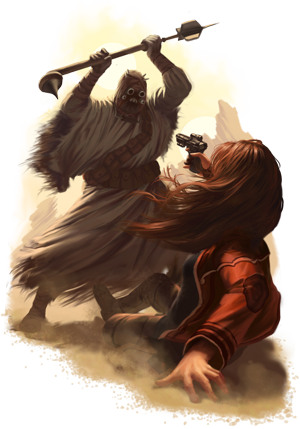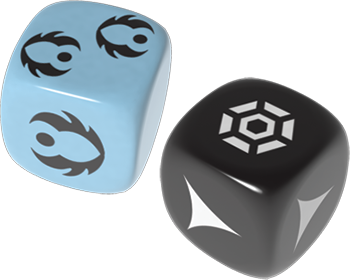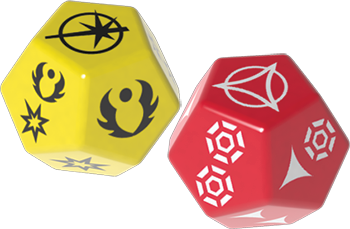
A desperate smuggler works feverishly to repair his starship’s hypermatter reactor igniter as an Imperial Star Destroyer closes in on his position. Colonists on the desert planet of Tatooine fire blasters from behind rocky outcrops as they defend their moisture farm from Tusken raiders. In the darkest alleys of Coruscant, a Bothan spy tries to stay one step ahead of the bounty hunters as he seeks a ride to Dantooine…
In the Star Wars ®: Edge of the Empire™ Roleplaying Game , players immerse themselves in interactive tales full of danger, excitement, and challenges. Whether you’re repairing a starship, exchanging blaster fire, or keeping a low profile in stressful situations, you’ll use your character’s skills and roll dice to determine the success or failure of your actions. Of course, since this is Star Wars , the action is fast-paced and entertaining, and each session blends moments of high drama with opportunity for some humor to cut the tension.
To keep your games rolling along, and to capture those thrilling twists of fate that make the Star Wars movies so entertaining, Edge of the Empire uses a pool of custom dice and a narrative dice system. Today, designer Jay Little looks at the narrative dice system and offers some examples of dice results in actual gameplay.
Designer Jay Little on the Narrative Dice System
 Edge of the Empire
’s innovative dice system is one of its signature features. The system uses custom dice that are rolled and compared as part of the game’s task resolution. Whether the characters are exchanging blaster fire with a stormtrooper patrol, slicing a holocron, or navigating an asteroid field in their YT-1300 light freighter, the players use the game’s dice to determine the outcomes of their efforts as they advance the story.
Edge of the Empire
’s innovative dice system is one of its signature features. The system uses custom dice that are rolled and compared as part of the game’s task resolution. Whether the characters are exchanging blaster fire with a stormtrooper patrol, slicing a holocron, or navigating an asteroid field in their YT-1300 light freighter, the players use the game’s dice to determine the outcomes of their efforts as they advance the story.
This dice system drew part of its inspiration from the system I designed and developed for Warhammer Fantasy Roleplay (WFRP) . The two systems both feature a variety of dice that are used for specific purposes, and both allow for a vast array of potential results. However, there are a number of significant differences, and I like to think of the Edge of the Empire dice as a “spiritual sibling” to the WFRP dice.
By the time I started designing the Edge of the Empire rules, I had had several years to develop, refine, and play around with the concept of a narrative dice system. This experience was invaluable and helped me think about how I wanted to reinforce the concepts of teamwork in Star Wars and encourage characters to interact with their environment. I also started to define which of the narrative influences from the Star Wars universe we wanted to make sure the dice system supported.
As with many roleplaying games, the core mechanics in Edge of the Empire revolve around dice. And as in many of these games, the dice serve one very important function: to help everyone at the table determine whether or not certain actions succeed. However, with the narrative dice system that powers the Edge of the Empire Roleplaying Game, that aspect of a task – the success or failure – is only one part of the equation.
More Than Success or Failure
The Star Wars setting delivers a wide range of experiences, from exciting speeder bike races and action-packed combat to heroes struggling with morality or embroiled in political intrigues that are clouded with uncertainty. To do Star Wars justice, it was important to make sure the game’s mechanics could help convey such a wide variety of scenes and encounters. That’s where the second part of the task resolution equation comes in. In addition to determining the success or failure of a task, the “narrative” aspect of the system also helps the players to determine how or why the task succeeds or fails.
The first step was to define what each type of die was going to represent and how it would contribute to the resolution of a skill check. I like the feeling of opposed forces and the struggle for balance in Star Wars – such as the light side of the force versus the dark side of the force, or the Rebellion versus the Empire – and I wanted the game system to reflect this sense of opposition. This led to the development of two sets of dice, one positive and one negative, in which each die had a counterpart.
Setback and Boost Dice
The Setback and Boost dice are six-sided dice that thematically mirror each other. They are generally added to a dice pool to represent minor situational modifiers or influences. For example, if a character was attempting to slice a security terminal, the GM could grant him an advantage and a Boost die for having the right tools for a task. Likewise, the task may be made more complicated by disadvantages – like trying to slice the computer under a hail of blaster fire – and the GM would add a Setback die to the dice pool.

Ability and Difficulty Dice
The Ability and Difficulty dice are eight-sided dice that are paired off against each other. These represent the innate qualities of a challenge. The Ability dice are a reflection of a character’s attributes and characteristics, such as how strong, smart, or willful the hero is. The Difficulty dice set the inherent difficulty of a task – slicing an outdated security terminal would likely feature fewer Difficulty dice than slicing a high-end security terminal.

Expertise and Challenge Dice
The Expertise and Challenge dice are twelve-sided dice that oppose each other. These represent significant improvements to Ability and Difficulty dice. The Expertise dice are “upgraded” versions of Ability dice, reflecting a character’s level of skill or specialized training applied to a task. The Challenge dice are “upgraded” versions of Difficulty dice, indicating that a task has greater risks involved or is being actively opposed by another character.

Narrative Dice in Action
Since each die in Edge of the Empire is associated with a particular contribution to the dice pool, players can both quickly determine the success or failure of the action and provide additional details about the result, based upon the type of dice on which the symbols for success and failure appear. They can also inform the story with the other symbols featured on the game’s dice.

Click the above thumbnail for an enlarged example of the narrative dice system in action. |
Continuing with the terminal slicing example, the players could trigger any number of additional effects or consequences, whether or not the character successfully slices the terminal. For example, the character may successfully slice the terminal, but he might take much longer than expected or set off a security subroutine that alerts the guards. Perhaps the character fails to slice the terminal, but gains access to a crucial piece of data during the attempt. He may even ruin the terminal in the process.
Both good and bad consequences can stem from any task – even a mix of both. One of the things I like most about this narrative dice system is that it provides information and context without getting in the way of the overall story.
For a relatively minor task, the players could roll the dice and worry only about success or failure without taking any of the other information into account. For dramatic scenes or important confrontations, the players might take that peripheral information and use it to detail the nuances and narrate how the action resolves. That information – the symbols and the types of dice those symbols appear on – is right there, built into the dice, ready to be used. It’s up to the players and the GM to decide how that information applies, and how it affects the ongoing narrative.
Thanks, Jay!
Not all successes are created equal. You can click on the thumbnail image above to find three examples from the Edge of the Empire core rulebook that illustrate how Advantages and Threats can have surprising consequences and lead to a more dynamic adventure.
With its ability to elicit details about the positive or negative side-effects of a character’s action as it determines the success or failure of that action, the narrative dice system from Edge of the Empire advances storytelling throughout your gaming sessions. You’ll quickly determine the results of each action, you’ll experience thrilling twists of fate, you’ll find humor existing alongside high drama, and you’ll remain rooted in that Star Wars feeling.
In a later preview, we’ll look at the system’s unique Force die and how the game’s Force users must remain sensitive to the balance of the Force. Next, though, Jay will explore the Obligation system in Edge of the Empire and how your character’s past can drive your sessions forward!